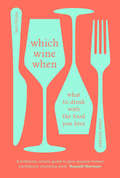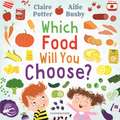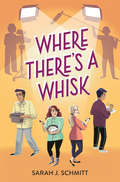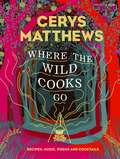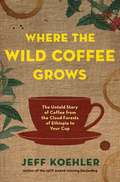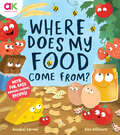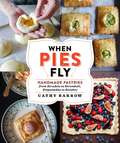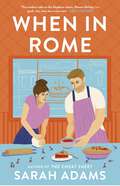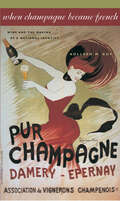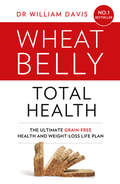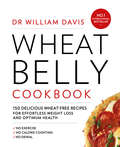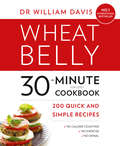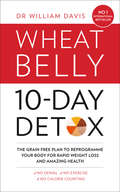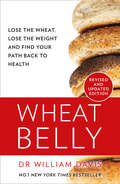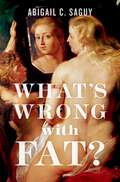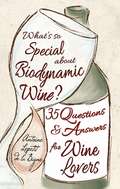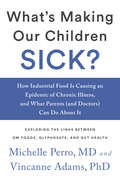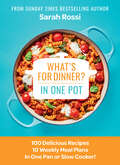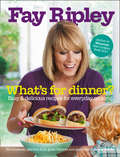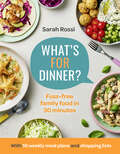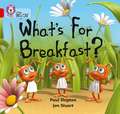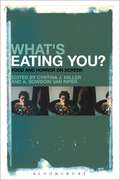- Table View
- List View
Which Wine When: What to drink with the food you love
by Bert Blaize Claire Strickett‘A brilliantly simple guide to give anyone instant confidence choosing wine.’ Russell NormanWhich Wine When offers brilliant wine matches to the food we eat every day. This is for anyone who knows their sourdough from their sliced white but still finds themselves standing in the wine aisle making panicked decisions about what to drink based on special offers, a vague memory or a nice-looking label. Now you’ll be able to look up dish or style of cooking and find three recommendations – and if the shop doesn’t have what you want, Bert and Claire give you the words to ask for the type of wine you’re looking for. From takeaways and snacks to Sunday lunches, home-cooked classics, cheese and desserts, these expert wine matches are fun, affordable and simple enough you can pop to a supermarket or local wine shop. Whether you’re ordering a curry, taking a bottle to a friend's, going out for dinner, or vegging out on the sofa with a bowl of pasta, Which Wine When will turn even the most down-to-earth meal into a magical combination of what’s on your plate and what’s in your glass. Don't wander the wine aisle without it.
Which Food Will You Choose?
by Claire PotterAn ingenious and entertaining picture book to entice your little fussy eater to look beyond 'beige' and explore a whole new colourful world of food! Mummy's in a bad mood. She's fed up of food like chicken nuggets, pasta, chips, cereal and crisps. Then she has an idea! She's going to take her children to the supermarket to play a game. On Monday she tells them to choose three RED foods, on Tuesday three YELLOW foods, on Wednesday three GREEN foods... Look at all the foods there are to choose from!Which three foods would YOU choose? And how would YOU eat them?The pages in this cleverly concocted picture book feature colourful illustrations of foods by Ailie Busby, encouraging the reader to pick the ones they'd like to try. Enjoy the story together and then take your child to the supermarket to play the game in real life! Recommended by paediatric dietitians to help with fussy eating, it's a fun and effective way to coax your child out of their comfort zone and encourage them to go for something new and different.From Claire Potter, the best-selling author of Getting the Little Blighters to Eat, and with gorgeous illustrations from Ailie Busby.
Which Food Will You Choose?
by Claire PotterAn ingenious and entertaining picture book to entice your little fussy eater to look beyond 'beige' and explore a whole new colourful world of food! Mummy's in a bad mood. She's fed up of food like chicken nuggets, pasta, chips, cereal and crisps. Then she has an idea! She's going to take her children to the supermarket to play a game. On Monday she tells them to choose three RED foods, on Tuesday three YELLOW foods, on Wednesday three GREEN foods... Look at all the foods there are to choose from!Which three foods would YOU choose? And how would YOU eat them?The pages in this cleverly concocted picture book feature colourful illustrations of foods by Ailie Busby, encouraging the reader to pick the ones they'd like to try. Enjoy the story together and then take your child to the supermarket to play the game in real life! Recommended by paediatric dietitians to help with fussy eating, it's a fun and effective way to coax your child out of their comfort zone and encourage them to go for something new and different.From Claire Potter, the best-selling author of Getting the Little Blighters to Eat, and with gorgeous illustrations from Ailie Busby.
Where There's a Whisk
by Sarah J. SchmittLife is what you bake it.Peyton Sinclaire wants nothing more than to escape her life as a diner waitress in her small, North Florida town and attend culinary school. Top Teen Chef, Food TV's new show that pairs reality TV drama with a fast-paced culinary competition, is her ticket out of her boring future. It's a once-in-a-lifetime chance to make her dreams come true and Peyton is determined to prove to herself, and the world, that where you're born does not determine where you can go. However, once on the show, Peyton quickly discovers that there is more to the competition than just a well-seasoned dish. As things start to heat up on and off the set, Peyton will have to prove to the judges that she deserves to win while trying to untangle what is real and what is scripted drama, and decide what she is willing to risk to win before her dreams end up on the chopping block.
Where the Wild Cooks Go: Recipes, Music, Poetry, Cocktails
by Cerys MatthewsA kitchen these days is a wonderful place. You can cook your way right round the world without spending a fortune and without even leaving your home. This is exactly what Cerys Matthews, food enthusiast, finds herself doing, with tried-and-tested recipes from all over the globe. Shall we go Spanish? Japanese? Scottish? Shall I cook inside? Light a fire?? Here, low-meat, vegan and vegetarian options, as well as cocktail recipes, offer up the world as your oyster. Accompanied by stories and folklore from each country, with a wonderful list of tracks to inspire while you cook and eat, this is a failsafe way to keep things interesting in the kitchen. With a recipe base and song list built over years of touring and discovering new places, Cerys has found that a simple list of ingredients and a great playlist on the go means there's always a ticket to ride.
Where the Wild Coffee Grows: The Untold Story of Coffee from the Cloud Forests of Ethiopia to Your Cup
by Jeff KoehlerCoffee is one of the largest and most valuable commodities in the world. This is the story of its origins, its history, and the threat to its future, by the IACP Award–winning author of Darjeeling.Located between the Great Rift Valley and the Nile, the cloud forests in southwestern Ethiopia are the original home of Arabica, the most prevalent and superior of the two main species of coffee being cultivated today. Virtually unknown to European explorers, the Kafa region was essentially off-limits to foreigners well into the twentieth century, which allowed the world's original coffee culture to develop in virtual isolation in the forests where the Kafa people continue to forage for wild coffee berries. Deftly blending in the long, fascinating history of our favorite drink, award-winning author Jeff Koehler takes readers from these forest beginnings along the spectacular journey of its spread around the globe. With cafés on virtually every corner of every town in the world, coffee has never been so popular--nor tasted so good.Yet diseases and climate change are battering production in Latin America, where 85 percent of Arabica grows. As the industry tries to safeguard the species' future, breeders are returning to the original coffee forests, which are under threat and swiftly shrinking. "The forests around Kafa are not important just because they are the origin of a drink that means so much to so many," writes Koehler. "They are important because deep in their shady understory lies a key to saving the faltering coffee industry. They hold not just the past but also the future of coffee."
Where Does My Food Come From?: The story of how your favourite food is made
by Annabel KarmelA fully illustrated non-fiction picture book that lets readers discover how their favourite foods are grown and made – with exclusive recipes from Annabel Karmel for each one.Images from renowned children's artist Alex Willmore make each food cheekily spring to life on the page, telling the story of its creation to the reader. Find out how eggs, cheese, tomatoes, pasta, strawberries, honey and chocolate are grown and made, and enjoy the fun, step-by-step food activities in each section too. Best of all, Annabel includes two fantastic, child-friendly recipes for each food. They're perfect for getting kids to create and eat wonderful meals with their favourite food – and for getting fussy eaters to try new foods too.
When Pies Fly: Handmade Pastries from Strudels to Stromboli, Empanadas to Knishes
by Cathy BarrowFollowing up on PIE SQUARED's slab pies, food writer Cathy Barrow finds more ways to use pastry dough deliciously with crowd-pleasing (and easy to make) galettes and small tarts, as well as empanadas, strudels, and knishes. Barrow digs into a world of doughs for turnovers, fried pies, poppers, and Texas-by-way-of-Krakow kolaches, all offered in sweet and savory iterations.WHEN PIES FLY guides the rolling pin novice and the experienced dough wrangler to dozens of shapes and styles of crusty, flaky, delicious treats. Barrow's well-tested, foolproof crust recipes means pie-making is fun, not scary, and her step-by-step techniques makes turning out a free-form pie practically foolproof.WHEN PIES FLY includes many types of pastries (both homemade and store-bought), ready for the lunchbox, the dinner table, road trips, and picnics. These handy crusty offerings go from freezer to oven, and will win over everyone at the table. No one will be able to resist Sesame Chicken Hand Pies, Savory Nectarine Marscapone Tarts, Pork Pastor Empanadas, Spiced Apple Strudels, and much more. The perfect mix of nostalgic favorites and new pastry creations, WHEN PIES FLY is a wonderful dive into the world of pies in all of their forms.
When in Rome: The charming new rom-com from the author of the TikTok sensation, THE CHEAT SHEET!
by Sarah AdamsA burned-out pop star stranded in small-town Kentucky can't help falling for her unlikely knight in shining armour - the notoriously grumpy owner of the local pie shop - in this charming slice of romance from the author of the TikTok sensation The Cheat Sheet.'This modern take on the Hepburn classic Roman Holiday is a quick, fun, slow-burn rom-com' ABBY JIMENEZ'Sarah Adams has written the Kentucky-set homage to Roman Holiday I never knew I needed. Full of cozy small-town vibes, a pie-baking hero (swoon!), and a slow-burn romance that will keep you flipping the pages, When in Rome is a charming and comforting escape' KERRY WINFREY'My Audrey Hepburn loving heart is so happy! When in Rome is a delectable romance, sweet and satisfying as a slice of warm apple pie' CHLOE LIESE 'Sarah Adams' books are woven with pure sunshine and rainbows . . . It's everything you could want in a small-town romance, along with a heaping dollop of her signature wit and sparkling charm' AMY LEA'You can always count on a Sarah Adams rom-com to be equal parts funny, sweet, and swoony' SOPHIE SULLIVAN.......................................Rome is where the heart is.Amelia Rose is burned-out from years of maintaining her public image as pop princess Rae Rose. Inspired by her favourite Audrey Hepburn film, Roman Holiday, she drives off in the middle of the night for a break in Rome . . . Rome, Kentucky, that is. Running the pie shop his grandmother left him, Noah Walker is busy enough as it is. But after finding Amelia on his front lawn in her broken-down car, he decides to let her stay in his guest room - on a very temporary basis, of course. As the two of them grow closer, Noah starts to see a new side to Amelia - kind-hearted and goofy, yet lonely from years in the public eye. Amelia may have to go back to her other life someday, but for now she's perfectly happy falling in love with the cozy small town she's found herself in . . . and her grumpy tour guide isn't half-bad either.........................................Discover The Cheat Sheet - the heartwarming friends-to-lovers romance that became a sensation on TikTok!'I just adored this story . . . I'm ready to eat up anything that Sarah Adams writes' 'A perfect mix of hilarious banter, comical situations, and sweet romance' 'This romance is brilliant! It is fast paced, laugh out loud and so cute!''A feel-good rom-com with everything you want in a romance!'
When Champagne Became French: Wine and the Making of a National Identity (The Johns Hopkins University Studies in Historical and Political Science #121)
by Kolleen M. GuyWinner of the Outstanding Manuscript Award from Phi Alpha Theta, this work explains how nationhood emerges by viewing countries as cultural artifacts, a product of "invented traditions." In the case of France, scholars sharply disagree, not only over the nature of French national identity but also over the extent to which diverse and sometimes hostile provincial communities became integrated into the nation. In When Champagne Became French: Wine and the Making of a National Identity, Kolleen M. Guy offers a new perspective on this debate by looking at one of the central elements in French national culture—luxury wine—and the rural communities that profited from its production.Focusing on the development of the champagne industry between 1820 and 1920, Guy explores the role of private interests in the creation of national culture and in the nation-building process. Drawing on concepts from social and cultural history, she shows how champagne helped fuel the revolution in consumption as social groups searched for new ways to develop cohesion and to establish status. By the end of the nineteenth century, Guy concludes, the champagne-producing provinces in the department of Marne had developed a rhetoric of French identity that promoted its own marketing success as national. This ability to mask local interests as national concerns convinced government officials of the need, at both national and international levels, to protect champagne as a French patrimony.
When Champagne Became French: Wine and the Making of a National Identity (The Johns Hopkins University Studies in Historical and Political Science #121)
by Kolleen M. GuyWinner of the Outstanding Manuscript Award from Phi Alpha Theta, this work explains how nationhood emerges by viewing countries as cultural artifacts, a product of "invented traditions." In the case of France, scholars sharply disagree, not only over the nature of French national identity but also over the extent to which diverse and sometimes hostile provincial communities became integrated into the nation. In When Champagne Became French: Wine and the Making of a National Identity, Kolleen M. Guy offers a new perspective on this debate by looking at one of the central elements in French national culture—luxury wine—and the rural communities that profited from its production.Focusing on the development of the champagne industry between 1820 and 1920, Guy explores the role of private interests in the creation of national culture and in the nation-building process. Drawing on concepts from social and cultural history, she shows how champagne helped fuel the revolution in consumption as social groups searched for new ways to develop cohesion and to establish status. By the end of the nineteenth century, Guy concludes, the champagne-producing provinces in the department of Marne had developed a rhetoric of French identity that promoted its own marketing success as national. This ability to mask local interests as national concerns convinced government officials of the need, at both national and international levels, to protect champagne as a French patrimony.
Wheat Belly Total Health: The Effortless Grain-free Health And Weight-loss Plan (Wheat Belly Ser.)
by Dr William DavisThe sequel to the bestselling Wheat Belly shows you how to take the advice one step further by going grain-free and discover the benefits of losing weight easily and achieving a level of radiant health and well-being you never thought possible.
Wheat Belly Cookbook: 150 Recipes To Help You Lose The Wheat, Lose The Weight And Find Your Path Back To Health (Wheat Belly Ser.)
by Dr William Davis150 delicious wheat-free recipes for effortless weight loss and optimum health
Wheat Belly 30-Minute (or Less!) Cookbook (or Less!) Cookbook (or Less!) Cookbook (or Less!) Cookbook: 200 quick and simple recipes: 200 Quick And Simple Recipes To Lose The Wheat, Lose The Weight, And Find Your Path Back To Health
by Dr William DavisIn his New York Times best-seller Wheat Belly, renowned cardiologist William Davis explained how eliminating wheat from our diets can prevent fat storage, shrink unsightly bulges and reverse myriad health problems. Now with his 30-minute (or less!) Cookbook you can put his advice into practice and see the difference it can make for yourself.
The Wheat Belly 10-Day Detox: The Effortless Health And Weight-loss Solution (Wheat Belly Ser.)
by Dr William DavisFor the first time ever, Dr. Davis presents a simple “10-Day Grain Detox Plan - all the advice and a superb selection of recipes.
Wheat Belly: Lose The Wheat, Lose The Weight, And Find Your Path Back To Health (Wheat Belly Ser.)
by William Davis, MDRenowned cardiologist William Davis explains how eliminating wheat from our diets can prevent fat storage, shrink unsightly bulges and reverse myriad health problems.
What's Wrong with Fat?
by Abigail C. SaguyThe United States, we are told, is facing an obesity epidemic-a "battle of the bulge" of not just national, but global proportions-that requires drastic and immediate action. Experts in the media, medical science, and government alike are scrambling to find answers. What or who is responsible for this fat crisis, and what can we do to stop it? Abigail Saguy argues that these fraught and frantic debates obscure a more important question: How has fatness come to be understood as a public health crisis at all? Why, she asks, has the view of "fat" as a problem-a symptom of immorality, a medical pathology, a public health epidemic-come to dominate more positive framings of weight-as consistent with health, beauty, or a legitimate rights claim-in public discourse? Why are heavy individuals singled out for blame? And what are the consequences of understanding weight in these ways? What's Wrong with Fat? presents each of the various ways in which fat is understood in America today, examining the implications of understanding fatness as a health risk, disease, and epidemic, and revealing why we've come to understand the issue in these terms, despite considerable scientific uncertainty and debate. Saguy shows how debates over the relationship between body size and health risk take place within a larger, though often invisible, contest over whether we should understand fatness as obesity at all. Moreover, she reveals that public discussions of the "obesity crisis" do more harm than good, leading to bullying, weight-based discrimination, and misdiagnoses. Showing that the medical framing of fat is literally making us sick, What's Wrong with Fat? provides a crucial corrective to our society's misplaced obsession with weight.
What's Wrong with Fat?
by Abigail C. SaguyThe United States, we are told, is facing an obesity epidemic-a "battle of the bulge" of not just national, but global proportions-that requires drastic and immediate action. Experts in the media, medical science, and government alike are scrambling to find answers. What or who is responsible for this fat crisis, and what can we do to stop it? Abigail Saguy argues that these fraught and frantic debates obscure a more important question: How has fatness come to be understood as a public health crisis at all? Why, she asks, has the view of "fat" as a problem-a symptom of immorality, a medical pathology, a public health epidemic-come to dominate more positive framings of weight-as consistent with health, beauty, or a legitimate rights claim-in public discourse? Why are heavy individuals singled out for blame? And what are the consequences of understanding weight in these ways? What's Wrong with Fat? presents each of the various ways in which fat is understood in America today, examining the implications of understanding fatness as a health risk, disease, and epidemic, and revealing why we've come to understand the issue in these terms, despite considerable scientific uncertainty and debate. Saguy shows how debates over the relationship between body size and health risk take place within a larger, though often invisible, contest over whether we should understand fatness as obesity at all. Moreover, she reveals that public discussions of the "obesity crisis" do more harm than good, leading to bullying, weight-based discrimination, and misdiagnoses. Showing that the medical framing of fat is literally making us sick, What's Wrong with Fat? provides a crucial corrective to our society's misplaced obsession with weight.
What's So Special About Biodynamic Wine?: Thirty-five Questions and Answers for Wine Lovers
by Antoine Lepetit de la BigneAre biodynamic wines any better than other wines? Are biodynamic methods, much talked about but little understood, scientific or not? What's the difference between organic and biodynamic? The popularity and availability of biodynamic wine has grown signficantly in the last few years, with more and more vineyards investing in biodynamic production. If you've ever wondered whether biodynamic wine is really worth it, and what all the fuss is about, this book is for you. In 35 clear and pertinent questions, expert biodynamic wine producer Antoine Lepetit explains what's so special about biodynamic wine.
What's Making Our Children Sick?: How Industrial Food Is Causing an Epidemic of Chronic Illness, and What Parents (and Doctors) Can Do About It
by Vincanne Adams Dr Michelle PerroExploring the links between GM foods, glyphosate, and gut health With chronic disorders among American children reaching epidemic levels, hundreds of thousands of parents are desperately seeking solutions to their children’s declining health, often with little medical guidance from the experts. What’s Making Our Children Sick? convincingly explains how agrochemical industrial production and genetic modification of foods is a culprit in this epidemic. Is it the only culprit? No. Most chronic health disorders have multiple causes and require careful disentanglement and complex treatments. But what if toxicants in our foods are a major culprit, one that, if corrected, could lead to tangible results and increased health? Using patient accounts of their clinical experiences and new medical insights about pathogenesis of chronic pediatric disorders—taking us into gut dysfunction and the microbiome, as well as the politics of food science—this book connects the dots to explain our kids’ ailing health. What’s Making Our Children Sick? explores the frightening links between our efforts to create higher-yield, cost-efficient foods and an explosion of childhood morbidity, but it also offers hope and a path to effecting change. The predicament we now face is simple. Agroindustrial “innovation” in a previous era hoped to prevent the ecosystem disaster of DDT predicted in Rachel Carson’s seminal book in 1962, Silent Spring. However, this industrial agriculture movement has created a worse disaster: a toxic environment and, consequently, a toxic food supply. Pesticide use is at an all-time high, despite the fact that biotechnologies aimed to reduce the need for them in the first place. Today these chemicals find their way into our livestock and food crop industries and ultimately onto our plates. Many of these pesticides are the modern day equivalent of DDT. However, scant research exists on the chemical soup of poisons that our children consume on a daily basis. As our food supply environment reels under the pressures of industrialization via agrochemicals, our kids have become the walking evidence of this failed experiment. What’s Making Our Children Sick? exposes our current predicament and offers insight on the medical responses that are available, both to heal our kids and to reverse the compromised health of our food supply.
What's for Dinner in One Pot?: 100 Delicious Recipes, 10 Weekly Meal Plans, In One Pan Or Slow Cooker!
by Sarah RossiThe second book in the Sunday Times bestselling What’s For Dinner? series by Sarah Rossi!
What’s for Dinner?: Easy And Delicious Recipes For Everyday Cooking
by Fay RipleyMumsnet Best Cookbook winner, Fay Ripley, is back with a no-fuss collection of simple, tasty recipes to take you from Monday to Sunday with ease.
What’s For Dinner?: Fuss-free Family Food In 30 Minutes - The First Cookbook From The Taming Twins Food Blog
by Sarah RossiThe new food bible for busy families!
What's for Breakfast: Band 02B/Red B (PDF)
by Paul Shipton Jon Stuart Cliff Moon Collins Big CatA picture story about three hungry ants. The ants want to know what is for breakfast but they are not keen on dad’s sweet offerings. Finally he suggests an apple; an offer that everyone is happy with. The book includes several discussion features, such as speech bubbles and a clock that shows the passing of time.
What's Eating You?: Food and Horror on Screen
by Cynthia J. Miller A. Bowdoin Van RiperDivided into four thematic sections, What's Eating You? explores the deeper significance of food on screen-the ways in which they reflect (or challenge) our deepest fears about consuming and being consumed. Among the questions it asks are: How do these films mock our taboos and unsettle our notions about the human condition? How do they critique our increasing focus on consumption? In what ways do they hold a mirror to our taken-for-granteds about food and humanity, asking if what we eat truly matters?Horror narratives routinely grasp those questions and spin them into nightmares. Monstrous “others” dine on forbidden fare; the tables of consumption are turned, and the consumer becomes the consumed. Overindulgence, as Le Grande Bouffe (1973) and Street Trash (1987) warn, can kill us, and occasionally, as films like The Stuff (1985) and Poultrygeist (2006) illustrate, our food fights back. From Blood Feast (1963) to Sweeney Todd (2007), motion pictures have reminded us that it is an “eat or be eaten” world.
